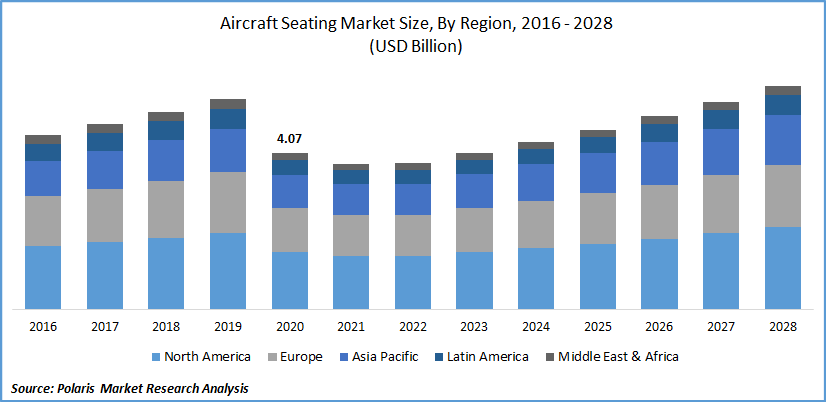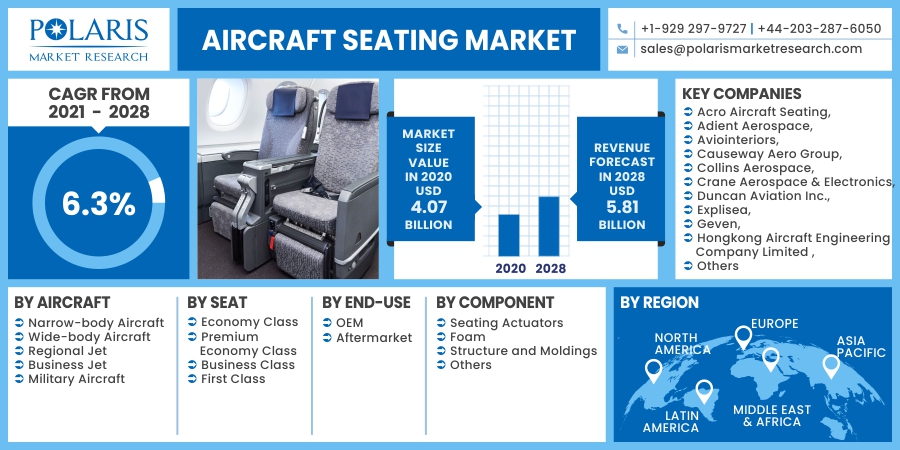
Aircraft Seating Market Share, Size, Trends, Industry Analysis Report, by Aircraft (Narrow-body Aircraft, Wide-body Aircraft, Regional Jet, Business Jet, and Military Aircraft), By Seat, By End-Use, by Component, and By Region; Segment Forecast, 2021 - 2028
- Published Date:Oct-2021
- Pages: 87
- Format: PDF
- Report ID: PM2002
- Base Year: 2020
- Historical Data: 2016 - 2019
Report Outlook
The global aircraft seating market was valued at USD 4.07 billion in 2020 and is expected to grow at a CAGR of 6.3% during the forecast period. Rising market demand of passengers for comfort and delightful experience onboard a flight, innovations in design and features of seats, and increasing market demand for lightweight seating are key growth impellers in the global aircraft market. Various design innovations such as improving degree of recline, value-added features, accessories attached to seating, and enhanced space & comfort for relaxation are proliferating the seating market across the classes.
 Know more about this report: Request for sample pages
Know more about this report: Request for sample pages
Amid pandemic in the year 2020, as per Jan 2021 estimates of ICAO (International Civil Aviation Organization), the capacity of passengers across the world dropped by about 50% year over year compared to 2019 levels. Air passenger traffic plunged by 60% in 2020, making it 17 years back to the 2003 levels. The outbreak of COVID-19 led to widescale lockdown measures, strict air travel restrictions, and grounding of majority of fleet of airplanes for a significant period in 2020.
However, governments worldwide continue to provide fiscal stimulus and accelerate vaccination drives, helping to reduce virus infection rates, thereby leading to gain in consumer confidence to travel and start adapting to new normal. Domestic air travel remains the bright spot with openings of state borders within countries across the world. However, international travel restrictions continue to be in distress for a longer period.
Industry Dynamics
Growth Drivers
Increasing market demand for lightweight seating along with high durability and reliability with a trend of reducing carbon emissions of airlines and generating fuel cost savings is one of the most significant factors driving the aircraft market growth. Integration of advanced technology-rich features in seating such as enhanced reclining and legroom integrated electronic support, and smooth transition between seat positions are also escalating the market demand across the globe.
Additionally, there is a growing need for cabin retrofits and upgrades where seating upgrades is one of the most desired upgrades to increase airlines value and save significant cost associated with conventional, outdated seating. Huge pile of older airplanes fleet among airlines is pushing the airlines to avoid overlooking retrofits and upgrades and avoid continued maintenance and repair costs.

Know more about this report: Request for sample pages
Report Segmentation
The market is segmented in the most comprehensive way based on aircraft, seat, end-use, component, and region.
|
By Aircraft |
By Seat |
By End-Use |
By Component |
By Region |
|
|
|
|
|
Know more about this report: request for sample pages
Insight by Aircraft Type
Increasing middle-class income level groups, especially in developing nations, have led to increased domestic air passenger seating capacity supporting the market demand for narrow-body aircraft worldwide. Increasing affordability of consumers has led to shift from ground transportation to economy class air transportation across the developing countries substantiating the narrowbody market. Furthermore, there has been fastest recovery of domestic air traffic after opening of lockdowns impelling the growth of narrow-body aircraft at an impressive rate.
Business jet accounts for a different set of opportunities for business class and first-class, thereby delighting customer experience with extraordinary luxury and comfort. Highly customized seats with value-added features such as bed convertibles, tray tables, power outlets, and advanced in-flight entertainments are the workhorses of business jet.
Insight by Seat
The economic class segment holds huge dominance in the market driven by the increasing market demand from low-cost carriers (LCCs). For example, Indigo, India’s largest low-cost carrier, has ordered over 700 A320 neo-family airplanes in the last decade, including 300 ordered in October 2019, representing strong opportunities for economy class seating.
Business-class segment is witnessing impressive growth in the global market. Airlines are setting up industry-standard with private experience for business class travelers, which is tending to be increasingly valuable during the pandemic. Integrating best suite of technology features such as wireless charging, dedicated phone holders, and extraordinary comfort with enhanced legroom and customizable reclining are some key attracting features of business class. In June 2021, Qatar Airways launched its 311-seat Boeing B787-9 Dreamliner with the latest business class suite Ascent havi a fully flat bed and sliding door option for greater piracy enhancing private space and technology-rich value-added features.
Insight by Component
The component, structure, and moldings secure the highest share of the market and are witnessing huge dynamics in the adoption of lightweight materials across the structures. There is a trend of replacing traditional metallic structures with modern lightweight composite materials with an aim to improve fuel economy and contribute towards reducing carbon emissions.
In May 2021, Expliseat’s world’s lightest seat was successfully logged into Airbus A320 BFE catalog due to its proven capability of being 40% lighter and highly durable over aluminum-based seat alternatives. TiSeat E2 offered by Expliseat has advanced seat frame construction composed of carbon fiber composites and titanium materials which starts with just 5kg per seat, saving significant weight and reducing fuel cost for airlines.
Seat actuators segment is attributed to witness excellent growth in the global market during the forecast period. There is increasing penetration of smart actuators on seating driven by growing passengers' need for outstanding comfort and smooth ergonomic seat motion. Integration of actuation systems reduces the overall weight, after-sales cost, or maintenance cost of seats and enhances passenger flying experience driving the growth of the segment.
Geographic Overview
North America holds the leading share in the aircraft seating market driven by host of factors such as stringent safety standards, one of the largest commercial and business jet fleet size, and technology leadership in modern seating solutions. Stringent safety regulations by US FAA (Federal Aviation Administration) to install 16G seats that adhere to rigorous safety standards. Furthermore, there is strong market demand for advanced lightweight materials in seating structures such as composite materials in the region.
Asia-Pacific region has huge growth potential, which has not yet been leveraged to represent an opportunity for industry stakeholders to penetrate the market. There is a strong market gap to integrate lightweight and technologically advanced seating in the region, which is highly dominated by low-cost economy seating across emerging economies. Premium economy and business class seating have been gaining traction in the region, driving the market growth.
Competitive Insight
Some of the key players competing in the global aircraft seating market are Acro Aircraft Seating, Adient Aerospace, Aviointeriors, Causeway Aero Group, Collins Aerospace, Crane Aerospace & Electronics, Duncan Aviation Inc., Explisea, Geven , Hongkong Aircraft Engineering Company Limited , Ipeco Holdings Ltd, Jamco Corporation, Mirus Aircraft Seating, Rebel Aero, Recaro Aircraft Seating, Safran, Stelia Aerospace, Thomsom Aero Seating, Zodiac Aerospace, ZIM Aircraft Seating.
Aircraft Seating Market Report Scope
|
Report Attributes |
Details |
|
Market size value in 2020 |
USD 4.07 billion |
|
Revenue forecast in 2028 |
USD 5.81 billion |
|
CAGR |
6.3% from 2021 - 2028 |
|
Base year |
2020 |
|
Historical data |
2016 - 2019 |
|
Forecast period |
2021 - 2028 |
|
Quantitative units |
Revenue in USD million/billion and CAGR from 2021 to 2028 |
|
Segments covered |
By Aircraft, By Seat, By End-Use, By Component, By Region |
|
Regional scope |
North America, Europe Asia Pacific, Latin America, Middle East & Africa |
|
Key Companies |
Acro Aircraft Seating, Adient Aerospace, Aviointeriors, Causeway Aero Group, Collins Aerospace, Crane Aerospace & Electronics, Duncan Aviation Inc., Explisea, Geven , Hongkong Aircraft Engineering Company Limited , Ipeco Holdings Ltd, Jamco Corporation, Mirus Aircraft Seating, Rebel Aero, Recaro Aircraft Seating, Safran, Stelia Aerospace, Thomsom Aero Seating, Zodiac Aerospace, ZIM Aircraft Seating. |
